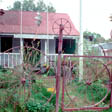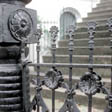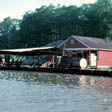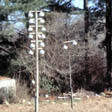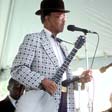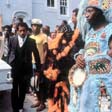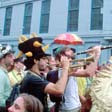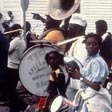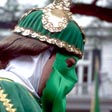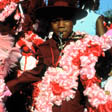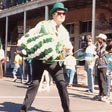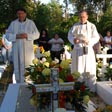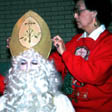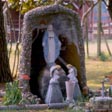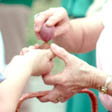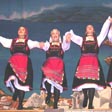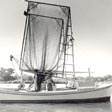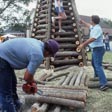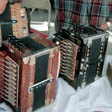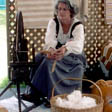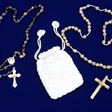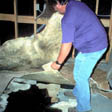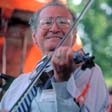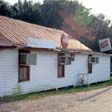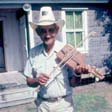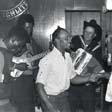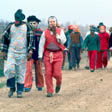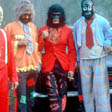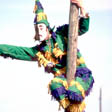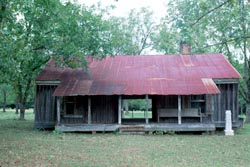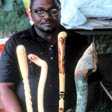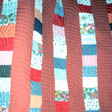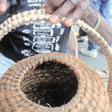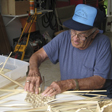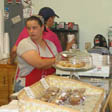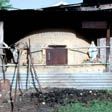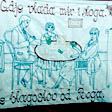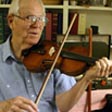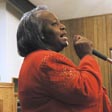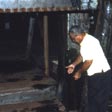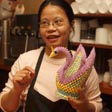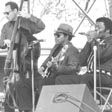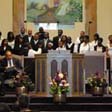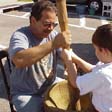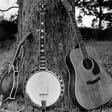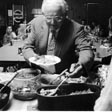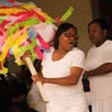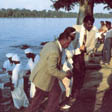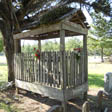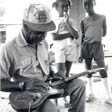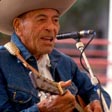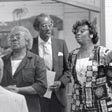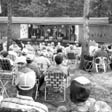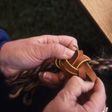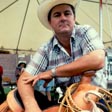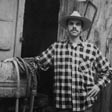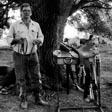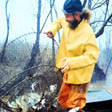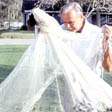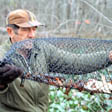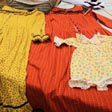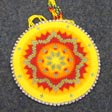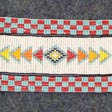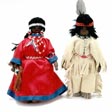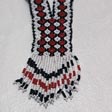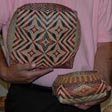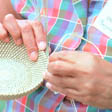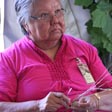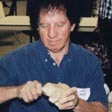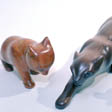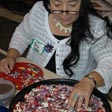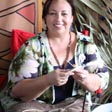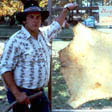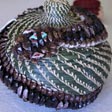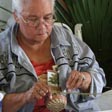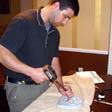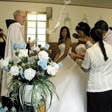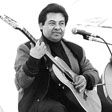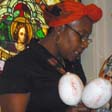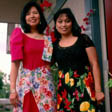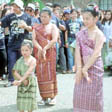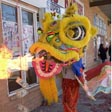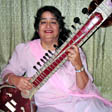Louisiana's Three Folk Regions
Adapted by Jocelyn Hazelwood Donlon
Introduction
You probably know that various regions of Louisiana are different from each other. South Louisiana is different from North Louisiana. Lafayette is different from New Orleans. Shreveport is different from Baton Rouge. However, you may not know that Louisiana can be divided into three different regions, based on their "folk culture." These regions are 1) New Orleans 2) South Louisiana and 3) North Louisiana.
There are many differences between these three regions. These differences are based on their geographies, immigrant histories, religions, and cultures. In fact, we can trace many of these differences to the variety of immigrant groups that settled in the three regions.
Native Americans were already in Louisiana when the French, Spanish, Africans, and English came. Also came groups of Irish, Germans, Italians, Czechs, Hungarians, Croatians, Filipinos, Latinos (Isleño, Mexican, Cuban, Guatemalan), and East Asians (Chinese, Vietnamese, Laotian, Thai). Each group has added to the state's culture and influenced it.
small towns, urban areas, bayou communities, and rural areas.
But it takes more than just knowing the types of immigrants that have settled in Louisiana over the decades. In order to truly understand a region's sense of place and its unique cultural traditions, you must investigate the history and the worldview of the people behind these traditions. In other words, to truly understand a basket, dance, or story made by someone, you should know about the culture of the person who made it.
New Orleans
New Orleans, an urban region, has a complex culture that is like no other in the world. It began with the Native Americans, especially Choctaws, who first settled in the area. Once Europeans arrived, New Orleans was governed, at different times, by the French, Spanish, and Americans. Today, New Orleans is home to these and people of African heritage (both French-speaking and English-speaking). The city also has Italians, Germans, Irish, Latinos, Greeks, Haitians, Filipinos, and Asians, including Vietnamese. Because of these different immigrant groups, New Orleans has many religions, primarily Catholic, Protestant, and Jewish. Each of the many cultural groups has left its mark.
Some people say that New Orleans is Cajun, but it is not. Many Cajuns did move to New Orleans' West Bank after World War II, and settled in Westwego and Marrero. But the first and largest group of French in New Orleans came directly from France. These people of French heritage often call themselves Creole. As used in New Orleans, the word "Creole" refers to two different groups: It can refer to the descendants of the French and Spanish settlers; also, it can refer to people of French, Spanish, and African descent.
Most Africans in Louisiana arrived enslaved from West Africa. Before 1730, two-thirds of the Africans came from the Senegambia. After the Haitian Revolution of 1791-1804, more Africans arrived. These Africans included many free-people-of-color, or gens de coleur libres, from the Caribbean, especially Haiti.

In other parts of the United States, enslaved Africans came from different parts of Africa. They had different cultures and spoke different languages. However, many Africans came to Louisiana from similar cultures, so they were able to keep some of their similar traditions. These traditions were important in creating the Creole culture in New Orleans and South Louisiana. For example, the Haitians brought the shotgun house and the voodoo religion to Louisiana, which still exist today.
Many free-people-of-color were highly educated and worked in the building trades. In fact, they built many of New Orleans' houses and buildings. They were also chefs who helped to develop New Orleans' world-famous Creole cuisine. For example, okra, which is an important ingredient of gumbo, was a favorite in Africa. (It originally came from the Middle East and brought to America by Portuguese traders.) What's more, the word "gumbo" is from the Bantu word nkombo.
After the Louisiana Purchase in 1803, Americans arrived and settled upriver (or uptown) from the Creoles. These two groups were divided by Canal Street. Then other groups came to New Orleans. Many Irish people, suffering from the potato famine of the 1840s, left Ireland and settled in New Orleans' Irish Channel. (The Irish Channel is between the Mississippi River and the Uptown Garden District.) Germans arrived in the 1850s. After 1865 and the Civil War, even more English-speaking African Americans came to Louisiana from other nearby Southern states to join the freed slaves. Even today, some Louisianans of French heritage refer to people of English heritage as "Americans" or, in French, Les Américains.
Jazz has played an important role in New Orleans culture. With jazz, different ethnic groups, who normally stayed separated, could come together temporarily to play music. African Americans, African Creoles, Italians, Germans, and Irish all contributed to this new art form. In New Orleans, musical traditions range from brass jazz bands to African Creole rhythms. African-American Delta blues and Latin salsa are some of the most frequently heard music styles today in local clubs. You can also hear the distinctive New Orleans rhythm and blues made famous by the likes of Fats Domino, Professor Longhair, and the Neville Brothers.
People in New Orleans love to parade, especially for Mardi Gras. Mardi Gras means "Fat Tuesday" in French and is the day before Lent starts. Lent is the 40 days before Easter and a time of sacrifice for Catholics. But the Mardi Gras season actually starts January 6. Krewes, or festive societies, have elaborate parades and balls during this season. Neighborhood groups have walking clubs or less elaborate truck parades. Some African Americans costume as Mardi Gras "Indians" in honor of Native Americans. In handmade feather and bead costumes, Mardi Gras Indian tribes have competitions around their costumes, songs, and dances. Each tribe or group has a name such as the "Wild Magnolias," "the Golden Star Hunters," and the "Yellow Pocahontas," and they sing "Indian chants" as they walk down the street.
Other parades are celebrated in New Orleans. The Irish parade for St. Patrick's Day (March 17) is similar to a Mardi Gras parade with green floats. In addition to green beads, people throw to the crowd the ingredients for potato stew, including heads of cabbage.
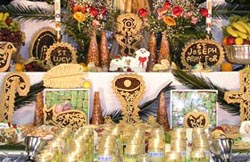
One tradition closely tied to Italian-Americans, who are mostly Catholic, is the St. Joseph altar. Catholics often promise God that they will build an altar if a favor has been granted, or if they hope a favor will be granted. The altar contains religious objects and food for the community, including special breads in the form of Catholic symbols. The food also includes casseroles, cookies, and cakes. Guests are given dried fava beans for luck. While an altar can be promised at any time to any saint, an Italian family will often build an altar in their home for St. Joseph, the patron saint of Sicily. The altar is usually built on or near St. Joseph's Day, March 19. Family, friends, and the community are invited to attend the blessing of the altar and the Feeding of the Saints, and to eat the food on the altar. More recently, Italian-American associations, such as the Grandsons of Italy, build a community altar that is publicized for the general public. St Joseph altars are built primarily in New Orleans, but you can also see them in other regions. They have regained popularity since the 1970s.
South Louisiana
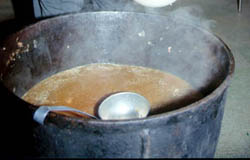
Rural South Louisiana can be described as a "cultural gumbo." Just as you can identify the ingredients of the gumbo you eat, you can identify ingredients of a "cultural gumbo." The ingredients are different from each other, yet they are all blended together. A blend of French, Spanish, German, African, Irish, and Native American influences have created a unique "cultural gumbo" in South Louisiana.
Many people think of South Louisiana as "Cajun," a local term for "Acadian." Cajuns are the descendants of French Acadians who were expelled from Nova Scotia by the British in 1755. They began arriving in Louisiana in 1765.
There are many Cajuns in South Louisiana, but there are other groups as well. French-speaking immigrants came directly from France, Canada, and the West Indies. In addition, Spaniards came from Spain, Texas-Mexico, and the Canary Islands. Germans, Irish, Africans, and a variety of Caribbean transplants also came to South Louisiana. Many of these groups blended with the Louisiana Native American groups.
French traditional culture in South Louisiana is largely found in a great triangular area on the state map: the top of the triangle is right below Alexandria, and the base stretches from New Orleans to Lake Charles.
While it was largely French, Southeast Louisiana also saw the arrival of many English planters. Plantation owners in Southeast Louisiana influenced the region in many ways: first, they were more likely to teach their enslaved Africans English rather than French; second, they were less isolated than people in Southwest Louisiana. This is because they were so close to New Orleans, and because they were on major transportation routes.
Some communities in South Louisiana have always been predominantly English-speaking. Many of these English-speaking, predominately white, communities relocated to the levees surrounding the Atchafalaya Basin. These levees were built in the late 1920s to control floods. Many individuals also moved to the Morgan City area, which was primarily English-speaking.
A large number of Germans arrived during the Spanish period, settling upriver from New Orleans along the German Coast (St. John and St. Charles Parishes). These Germans provided most of the vegetable crops needed by New Orleans.
In Southwest Louisiana, French-speaking people lived a somewhat isolated life along the bayous and on the prairies. Because there were so many French people, French culture was dominant in South Louisiana. As a result, other cultures had to adapt to French ways. These other cultures included Germans, Spanish, British Americans, and Native Americans. During the late 19th century, large numbers of Midwesterners from Indiana settled the Cajun prairie. They wanted to work in the newly developing rice industry and with the railroad. Within a relatively short period of time, many of these new arrivals had adapted to French culture.
Today, many French-speaking people who identify themselves as Cajuns may have such surnames as Frey (German), Smith (English), McGee (Irish), and Manuel or Rodrigue (Spanish). These names are in addition to Acadian surnames, such as Bergeron, Broussard, LeBlanc, or Mire, and the French colonial army surnames of Fontenot or Fusilier (Brasseaux 1992).
The French-speaking black Creoles of the Southwest Louisiana prairie have lived alongside the Cajuns. When they first arrived, Creoles were often free-people-of-color and landowners. Today, Cajuns and Creoles share many cultural traits, including food, Mardi Gras, Catholicism, music, and language. Zydeco is a significant Creole contribution. It is a distinctly black Creole music that blends French songs and African/Caribbean rhythms.
Many people are aware that the Cajuns contributed Cajun dance music, with two-steps, waltzes, and ballads. They also know about Creole zydeco music, with its African influence. But more recently (in the early 1950s) the mix of Cajun and Creole culture created music called "swamp pop." Similar to the rhythm and blues music of New Orleans, swamp pop combines rhythm and blues with Cajun & black Creole music and with country & western. Swamp pop is common throughout South Louisiana and some of East Texas.
Many restaurants and dance halls provide Cajun and Creole music for both tourists and locals. And Cajuns and Creoles are also well known for their special foods (crawfish étouffée, gumbo, bisque, sauce piquante, jambalaya).
While outsiders often know about the food and music of South Louisiana, they seldom know about Cajun and Creole crafts. These crafts include cowhide chair bottoms, wooden boats (skiffs, luggers, pirogues), Acadian brown cotton weaving, accordion building, fiddlemaking, and Job's (pronounced to rhyme with "globe") Tears rosaries.
Throughout South Louisiana and New Orleans, Catholicism has been the dominant religion since colonial times. In Cajun and Creole prairie communities, they observe the Catholic holiday Mardi Gras with le courrir de Mardi Gras ("Mardi Gras run" in French). The participants go from house to house either on horseback or by truck. At each house, they gather ingredients for a community gumbo. Together, they cook a good meal and have a lively party before Lent begins on Ash Wednesday.
North Louisiana
North Louisiana includes parishes north of "the French triangle," as well as the "Florida Parishes" north of Lake Pontchartrain. Even though the Florida Parishes are closer physically to south Louisiana, they share historic settlement patterns more with north Louisiana. Both northern regions have historically been populated primarily by British immigrants (from England, Scotland, and Ireland) and African Americans.
There are two primary subcultures within North Louisiana: 1) the Upland South hill culture and 2) the Lowland South plantation culture. Both are mainly Protestant, but there are important differences between them.
The Upland South region was settled by Scotch-Irish immigrants from Georgia, Alabama, South Carolina, Mississippi, and Tennessee. The majority of these immigrants were Baptist or Methodist. They were usually small farmers with a strong Protestant work ethic, and few of them owned enslaved Africans in large numbers.
The Lowland South region in Louisiana was settled by Englishmen and Scots. They came from other Southern states and New England. These settlers established cotton plantations in the region where the Mississippi, Red, and Ouachita Rivers come together. Their plantations depended on a large enslaved population. This is why there are so many rural blacks who live there today. Most of these settlers were Methodists, Presbyterians, or Episcopalians.
There are also other ethnic groups among the Upland and Lowland South cultures. Hungarians in Tangipahoa Parish continue their dance, music, food, and costume traditions. Also, the Hungarian language has been taught in the elementary school in an effort to save it. Czechs in Rapides Parish have revitalized their dance, song, food, and costume traditions. Some rural Italian communities also remain. One community lives around the town of Independence in Tangipahoa Parish (one of the Florida Parishes), where strawberries are farmed. People in the town of Independence often make strawberry wine. Another rural, conservative Italian community is located around Powhattan in Union Parish, in North Louisiana.
The Mississippi River Delta Region and the Red River Delta are home to Lowland South culture. Upland South culture can be found between the Mississippi and Ouachita Rivers. In the cities of Monroe and West Monroe, these two cultures come together.
In northeast Louisiana, the Mississippi River delta (which is an area around the mouth of the river) has low land and a few large towns. The larger cities—Vicksburg and Natchez—are across the river, in the state of Mississippi. However, they also served the lowland Louisiana side. This is why you'll see signs in the region saying "Miss-Lou." People in the region can easily drive across the Mississippi River Bridge, to the next state, to go shopping or eat in a restaurant.
This area has a folk culture based on open-range hogs. These hogs were managed by Catahoula curs, a dog breed developed in the area. From the late 1800s until the mid-1900s, settlers raised free-ranging hogs for pork and lard. These products were sold in New Orleans. Today, Catahoula curs are still valued. In fact, the Catahoula is Louisiana's state dog. A few people in the Lowland South still raise free-ranging hogs, and pork remains an important food in their diet.
Shreveport, Natchitoches, and Alexandria are Lowland South cities along the Red River. Each city was, at one time, tied to large plantations. Shreveport, the largest city in North Louisiana, is home to a diverse mix of British Americans (especially Scotch-Irish), African Americans, Italians, Lebanese, Germans, Greeks, Chinese, and Jews. In the past, Shreveport had a significant downtown community of Italian grocers, Chinese restaurants, Jewish merchants, and a German bakery. While few downtown merchants remain today, Shreveport is still home to their descendants. In Minden, near Shreveport, German immigrants started a colony that lasted until 1871.
Founded in 1714, Natchitoches was the earliest settlement in the Louisiana Purchase. It was settled by the French, who wanted to tie into the Indian trade system. In the Red River Valley, trade was dominated by the Caddo Indians. The influence of the French settlers is still evident in the foodways (Natchitoches meat pies) and the architecture. The Isle Brevelle is on the nearby Cane River. This is a rural community of Creoles who are descended from a freed slave woman.
Upland South farmers settled between the lowlands of the Mississippi River and the Boeuf River/Ouachita River basins, along the Maçon Ridge. Here, commercial fishermen and their families maintain the work-related traditions of boatbuilding, trapmaking, and netmaking.
The twin cities of Monroe and West Monroe on the Ouachita River reveal the contrast of North Louisiana's two dominant cultures: Lowland and Upland South. Monroe, on the east bank with rich delta soil, was settled first by Lowland South planters. They were more likely to have larger tracts of land and to allow alcohol and dancing in social settings. Upland South people settled in West Monroe. They were farmers on the west bank, with higher land and piney woods. West Monroe is less likely to have alcohol at community and social events because of the Baptist influence.
To the west along the Texas-Louisiana border, one finds the remains of "No-Man's Land." This region used to be a hideout for outlaws. The colonial town of Los Adaes, near Robeline, was once a capital of Texas. In Los Adaes, colonial Spanish influence is evident today—in the Catholic church, and in the tamales and chilies. These Spanish and the Apache-Choctaw and Caddo-Adaes Indians still work at cattle raising and lumbering.
Most of the Florida Parishes are Protestant and rural, and dominated by Upland South culture. There are small farms and towns in the piney woods that make up this region. The Florida Parishes were once part of the colonial Spanish territory of "Florida."
Louisiana's state capital, Baton Rouge, is a British-American town in spite of its French name. It is home to a multicultural community of Italians, Cajuns, African Americans, Lebanese, Asians (particularly Vietnamese), and others.
North Louisiana craft traditions reflect the skills used on farms and plantations, which makes up the predominant economy of this region. Whipmaking, knifemaking, saddlery, trapmaking, split-oak basketmaking, and quilting are still vital and practiced by many. A few people still enjoy carving toys, blacksmithing, making lace by hand, carving walking sticks, soapmaking, and making birdhouses out of gourds.
Food traditions include many relishes (to add flavor to field peas and cornbread); jellies, jams, and preserves; vegetable crops (corn, sweet potatoes, greens, beans, peas); hogs; and cattle. Many North Louisianans still eat and hunt wild game (venison, squirrel, raccoon, rabbit, and quail) and fish (both farm-raised catfish and gamefish such as crappie and bream). All of these meats may be fried. Sunday dinners-at-noon, fish fries, and barbecues are common occasions for the gathering of family and friends.
Ritual traditions reflect the strong Protestant heritage of the area. In a few places, there are still all-day singings and dinners-on-the-ground after church services. Both black and white rural churches have "Homecomings," which bring together families and their distant relatives. Some rural church congregations still conduct baptisms in the same river or lake used for generations.
Gospel music is probably the strongest traditional form of music among both blacks and whites. Quartets and choirs are heard in churches, on the radio, and at festivals throughout the region. Shape-note singing, a musical notation system using seven shapes to represent the musical scale, is still practiced in North Louisiana. And singing conventions are held annually.
Other music traditions shared by British Americans include old-time country and bluegrass. Weekly country music shows, such as the former Dixie Jamboree in Ruston and Louisiana Hayride radio show in Shreveport, reflect this heritage. Bluegrass festivals, which usually forbid alcohol, have been popular since the introduction of bluegrass in the 1940s. The region is also the home of "rockabilly." This is a relatively new form of rock and roll that grew out of Ferriday, in Concordia Parish. Jerry Lee Lewis, a famous musician from Ferriday, made it popular. Rockabilly blends country music with Mississippi Delta blues.
African Americans in North Louisiana sing both "country blues" and "city blues" music. Country blues came from the field hollers (songs sung in the fields while working) and slave songs of the past, and they often feature a single musician who accompanies himself with an instrument and uses improvisation (to make music up on the spot). City blues is usually more structured and the singer is more often accompanied by a band.
Cowboy culture is one trait shared by both North and South Louisiana. Cowboys in Louisiana may be British American, African American, Cajun, or Creole. Rodeos, trail rides, and the making of braided whips, horsehair ropes, and leather saddles flourish. You can find cowboy culture from Monroe to Cameron Parish, and from Shreveport to Hammond. Performances found in cowboy culture include reciting cowboy poetry, auctioneering in French or English, and singing cowboy ballads in clubs and at festivals.
Native Americans
Many people are surprised to discover that Louisiana has a significant Native American population. In fact, it is the largest within the eastern United States. Louisiana tribes and bands have played a significant role in shaping the distinctive culture of the state, both north and south.
Many of the original inhabitants of Louisiana shared their culture with the newly arrived Europeans and Africans, teaching them how to take advantage of the land. Filé (powdered sassafras for gumbo), place names (Atchafalaya, Kisatchie), and hunting and fishing practices, (such as handfishing) should be credited to the Native Americans.
The Chitimacha, Houma, Tunica-Biloxi, and Caddo were the only four tribes in Louisiana when Europeans arrived. The tribes survive today, although they don't live where they originally settled, except for the Chitimacha.
Other Louisiana tribes, including the Choctaw and Koasati, were forced to relocate to the state during the Spanish period.
The Tunica-Biloxi, Chitimacha, Koasati, and Jena Choctaw have been federally recognized and have reservations (land set aside for Indians). In addition to these four tribes, Louisiana officially recognizes the Houma, Clifton-Choctaw, Choctaw-Apache of Ebarb, Caddo-Adais, and Four Winds Cherokee Tribe. The tribes are presently gaining more recognition.
The Chitimacha, a small tribe of about three hundred members located at Charenton, in St. Mary Parish, is world-renowned for its river cane basketry. A handful of individuals continue to make the double and single weave baskets in traditional patterns. The designs date from 1200-1600 A.D. The tradition is passed on exclusively within the Chitimacha tribe.
The Houma, the largest tribe in Louisiana, numbering about 10,000, live along the bayous of Terrebonne and Lafourche Parishes. Until recently, they have emphasized fishing and trapping. Crafts include weaving palmetto (a native plant); curing Spanish moss to make dolls, bags, and mattresses; and carving duck decoys and model pirogues (dugout boat).
The Koasati (also known as Coushatta) live outside of Elton in Allen Parish. They have maintained their native language, and some families speak only Koasati in their homes. This tribe is known for its pine straw baskets. They also make traditional river cane baskets for their own use as well as for sale.
The Apalachee Indians followed the Spanish from Florida in 1763 to avoid the English. The core of their community is currently the Emmanuel Catholic Church at Sang-Pour, near Cloutierville in Natchitoches Parish.
Several Choctaw bands are located in Louisiana. Those in Jena (LaSalle Parish) and in Clifton (Rapides Parish) maintain close-knit communities. The folk art of both of these tribes has been documented.
Other Native American tribes include the Apache-Choctaw (Sabine Parish), the Caddo-Adais (Natchitoches Parish), and the Tunica-Biloxi (Avoyelles Parish). Each community has its own crafts traditions. The Tunica-Biloxi maintain their annual sacred corn feast and continue to live on lands they have held for over two centuries. Their storytelling traditions and some of their songs survive.
The Apache-Choctaw and Caddo-Adaes still live near the 18th-century Spanish outpost of Los Adais. Their ancestors converted to Catholicism and learned Spanish. Tamales, salsas, and picantes are included in their food traditions; they often carve, plait whips, and do leatherwork.
Conclusion
Many other ethnic groups live in Louisiana, but their traditional culture has not yet been documented for presentation to others. Many independent, small-town motels are owned and operated by East Indians. Lebanese peddlers followed the railroads and rivers and settled in many small towns as merchants and grocers. Chinese merchants can also be found in both large cities and small towns. Louisiana is also home to Africans, Greeks, Pakistanis, Iranians, Japanese, Koreans, Laotians, and Vietnamese.


